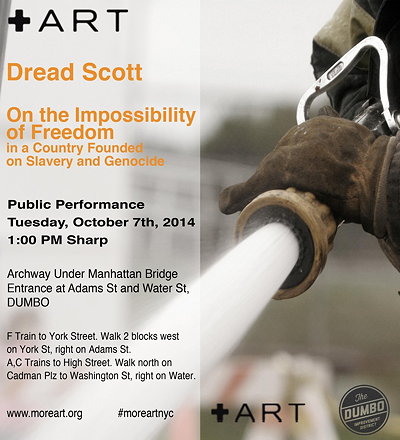Performance Art
The Living Theatre, Deceased
With the death this month of Judith Malina, the world will be forever deprived of "happenings" like the one in the first clip, where, I regret, Ms. Malina does not appear until the final few seconds.
Posted By: Paul - Sat Apr 18, 2015 -
Comments (1)
Category: Drugs, Avant Garde, Outsider Art, Performance Art, Pop Art, Obituaries, 1970s
Typing to Music
Posted By: Paul - Tue Mar 03, 2015 -
Comments (5)
Category: Music, Performance Art, Appliances, 1930s
Hidden Artist
Cuban performance artist Alejandro Figueredo Diaz-Perera plans to spend three weeks living inside the walls of a Chicago art gallery. He's titling this performance piece "In the Absence of a Body." The Chicago Arts Coalition, which is hosting Diaz-Perera, elaborates:The concept kinda reminds me of Vito Acconci's 1972 performance piece Seedbed, in which he spent 3 weeks hidden beneath a ramp in an art gallery, loudly pleasuring himself. I'm guessing that over the course of 3 weeks, Diaz-Perera will probably also indulge in a bit of that. More info at HuffPost.com.

Posted By: Alex - Thu Feb 19, 2015 -
Comments (4)
Category: Art, Performance Art
Bambi the Fire Goddess

The only other internet reference I can find about "Bambi the Fire Goddess" seems to date her act as far back as 1965. (This foto is from 1970.) It appears then that she had the problem of scorched vajayjay under control.
Posted By: Paul - Thu Feb 19, 2015 -
Comments (5)
Category: Daredevils, Stuntpeople and Thrillseekers, Performance Art, 1970s, Dance
Sandrine Schaefer
Recently won a prize with an undisclosed sum of cash attached.
Posted By: Paul - Fri Feb 06, 2015 -
Comments (5)
Category: Ineptness, Crudity, Talentlessness, Kitsch, and Bad Art, Performance Art
Christopher Paolini Reads “The Eye Of Argon”
The history of the tale.
Posted By: Paul - Wed Dec 17, 2014 -
Comments (4)
Category: Ineptness, Crudity, Talentlessness, Kitsch, and Bad Art, Performance Art, Fantasy
Virtual Reality Experiment
UK artist Mark Farid wants to spend 28 days wearing virtual reality goggles, and he wants all of us to pay for it. His plan is that by wearing the goggles he will "experience life through another person's eyes and ears." This person whose life he'll be experiencing is only known as "The Other."Farid is raising money on Kickstarter to make this plan a reality, and he figures he can do it for £150,000. That's around $235,000.
Why so much? Because, says Farid, the experiment "will require a team of medically trained invigilators at all times over the course of the 28 days as well as camera men, technicians and assistants on site 24 hours a day. This means sleeping accommodation and amenities must be provided for them onsite."

Posted By: Alex - Wed Nov 19, 2014 -
Comments (6)
Category: Art, Performance Art, Experiments
Firehose Art
If you go to the Manhattan Bridge Archway in New York City tomorrow, you can witness artist "Dread Scott" repeatedly trying to walk into the blast of a high-pressure water hose. He calls this performance "On the Impossibility of Freedom in a Country Founded on Slavery and Genocide." As you watch it, you're supposed to be reminded of crowd control tactics of the past and think about the ongoing struggle for equality. At least, that's the official takeaway.
Posted By: Alex - Mon Oct 06, 2014 -
Comments (5)
Category: Art, Performance Art
Michal Samama
Let me know how far you get into this performance.
Her home page.
Maybe you'd like to catch her newest exhibition in NYC:
In the theater, Ms. Samama, with a whistle in her mouth, removes her clothing and lies on the floor next to the room’s white brick wall. Stretching her legs up the wall and folding them into her belly, she travels in a continuous spiral along its perimeter. It’s painstaking work, and her labored breathing is audible through the whistle.
Posted By: Paul - Mon Oct 06, 2014 -
Comments (15)
Category: Body, Ineptness, Crudity, Talentlessness, Kitsch, and Bad Art, Performance Art
The Art of the Diseuse
Not sure these recorded performances capture whatever unique brilliance these performers were reputed to exhibit.
In the December 21, 1935 edition of the Pittsburgh Post-Gazette an entertainment columnist wrote: “The English language does not contain a word which perfectly describes the performance of Ruth Draper, who comes to the Nixon next Thursday for the first time in several years to give a different program at each of her four performances here. “Speaking Portraits” and “Character Sketches” are the two terms most frequently applied to Miss Draper's work; and yet it is something more than that. “Diseuse” is the French word, but that is more readily applicable to an artist like Yvette Guilbert or Raquel Meller. Monologist is wholly inadequate. The word “Diseuse” really means “an artist in talking” so that may be the real term to use in connection with Miss Draper.” Actresses who have been called noted diseuses over the years include Yvette Guilbert, Ruth Draper, Joyce Grenfell, Cornelia Otis Skinner, Lucienne Boyer, Raquel Meller, Odette Dulac, Beatrice Herford, Kitty Cheatham, Marie Dubas, Claire Waldoff, Lina Cavalieri, Françoise Rosay, Molly Picon, Corinna Mura, Lotte Lenya.
Source of quote.
Posted By: Paul - Mon Sep 29, 2014 -
Comments (5)
Category: Performance Art, 1930s, 1960s

| Who We Are |
|---|
| Alex Boese Alex is the creator and curator of the Museum of Hoaxes. He's also the author of various weird, non-fiction, science-themed books such as Elephants on Acid and Psychedelic Apes. Paul Di Filippo Paul has been paid to put weird ideas into fictional form for over thirty years, in his career as a noted science fiction writer. He has recently begun blogging on many curious topics with three fellow writers at The Inferior 4+1. Contact Us |




